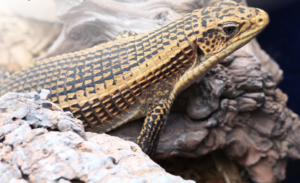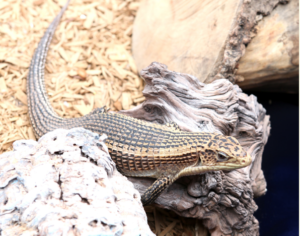Not many have heard of the Sudan plated lizard, and that’s a loss, says our expert, Lendl Lin.
“In my opinion, the plated lizard is one of the most attractive lizards in the reptile keeping scene. Sudan plated lizards are like dragons with armor. Plus, they are very easy to keep. They’re quite alert and active as well. They feed mainly on insects like roaches and superworms,” he says by way of an overview.

Many lizards currently popular on the reptile keeping scene are fairly easy to keep—hence their popularity—but the Sudan plated lizard has a few interesting quirks. Let’s start with the basics.
Q: How big does the Sudan plated lizard grow? What does it feed on? What are the special considerations for its care?
A: Size would be around 18-25 inches. They are primarily insectivores, that’s why it is ideal to give them insects like crickets, worms, and roaches. But it is also a good idea to give them a few greens from time to time—but only IF they will take it.
Q: It’s been said online that the Sudan plated lizard is one of the easiest reptiles to keep; is this correct in your experience? What are the challenges of keeping one, in your experience?
A: The only challenge I experienced with the Sudan is the temperament, especially when it wasn’t fully acclimated yet when it first explored his new enclosure. Most of the time, it was hiding, and it would try to run away from the keeper.
Q: Is it light-sensitive?
A: It is actually not that sensitive to light but tends to be uncomfortable whenever it is being brought out of its enclosure. It could be sensitive to light if you use the wrong lighting.
Q: What is unique about its ‘armored’ skin?
A: Coming from the name itself, the skin resembles body armor, which I usually refer to as ‘samurai armor’ (just for fun). It has goldish and shiny plates that will give you the impression of it being heavily “armored’ and maybe can make a potential predator lose its interest in making dinner out of the Sudan plated lizard!

Q: Like smaller lizards, some specimens of the Sudan plated lizard have been observed to shed their tails. What other behavior should owners know about?
A: Like other lizards, the Sudan plated lizard can drop its tail and regenerate it, but this causes unnecessary stress for the animals, so handle them with care. They do drop their tails if they get threatened, or whenever they’re not comfortable with how they’re handled. So if you see the animal in this way, I suggest that you leave them alone for a while.
Q: It is also said that Sudan plated lizards develop interesting personalities and can be quite friendly; was this the case for you?
A: Yes, my Sudan has always been curious and is very active, especially during feeding time.
Q: Where can a Pinoy beginner acquire a Sudan plated lizard legally, and what accessories will s/he need? What kind of habitat should they provide? What substrate do they need?
A: Pinoy keepers could get their reptiles from breeders who have wildlife farm permits and have legal papers (to prove they are not endangered or illegally sourced).
As for its enclosure, I gave mine a Habba hut that serves as its ‘hide’, mopani wood for basking, and reptibark as their substrate. (All these are available from Zoo Med Laboratories.)
Q: They are said to be very docile in Wikipedia; other sources say they rarely bite. Is this true in your opinion and do they make good pets?
A: Yes it is true that it is very docile and they rarely bite. They are indeed great pets! They
are not aggressive; in fact, I have never heard of Sudan plated lizards biting their keepers.
Q: Care sheets say that they should have UVA and UVB light. How can keepers protect themselves (since this is not good for humans)?
A: There are UVBs that are very hazardous for all living things. We have tested a UVB that emits high levels of UV which can cause blindness in reptiles and complications with humans. What we are using right now is the Zoo Med Reptisun 5.0 for the Sudan Plated Lizard. Zoo Med Reptisun/Powersun emits the right amount of UV for our reptiles to utilize and has been made safe for humans as well. But anything that emits radiation or UV is considered quite hazardous and looking directly at it for a long period of time should be avoided.

Q: Does the Sudan plated lizard’s ‘armor’ actually protect it from bites and claw strikes?
A: They can protect the animal to a certain point but just like the bearded dragon, to me its just used for intimidation and camouflage.
Q: Do you recommend them for beginners or should an owner already have experience with other lizards first?
A: Well, for every animal or before getting any other animal, the keeper should do extensive research and seek out advice from experienced keepers before keeping any living thing.The
Basics:
• Scientific name: Gerrhosaurus major
• Also known as the “tawny plated lizard” and the “Great plated lizard”
• Origin: Savannah areas in Sudan and nearby African countries
• Size: Considered a fairly large lizard; expert care sheets estimate adults reach up to 70 centimeters (cm) in length, with the tail ac-counting for half of this. (Trivia: Most lizards have tails that are longer than the length from their snouts to their vents; the opposite is true of the Sudan plated lizard.) Freshly hatched Sudan plated liz-ards usually measure up to 6 inches in length.
• General description: Most heavily ‘plated’ of its species, its body and tail sport, according to Wikipedia, “…transverse bands of more or less square plate-like scales, and head shields are fused to the skull.” Their undersides are smooth and pale-colored, in contrast. Their necks and tails are quite thick. Males are generally larger than females; both sexes come in shades of brown, but males have brighter throats. A lateral fold runs along its body length and allows the animal to temporarily expand itself to look more threatening.
• Life expectancy: Up to 10 years in captivity; 5-10 years in the wild if it survives to adulthood
• Living habits: Diurnial (active in the day, sleeps at night)
• Preferred temperature range: 70-85o F; basking spot should ideally have temperatures of up to 100o F; nighttime temperatures should be kept between 60-75o F. They need a high output (10%) UV lamp

• Natural habitat: Rocky desert
• Fight or flight?: They flee for cover and this, coupled with their tough ‘armored’ skins, makes them hard to prey upon. They use their tails as whips too.
• Diet: Omnivorous• Habitat requirements: Large ter-rariums of up to 50 gallons in capac-ity, preferably 4 feet long and about 2.5 feet wide; UV source; access to natural light while still offering the Sudan plated lizard the option to hide from it; a basking spot; suffi-cient semi-moist substrate for bed-ding and burrowing (recommended humidity is between 50-70%); water dish.
(Note: If your Sudan plated lizard is soaking in the water dish, it is likely dehydrated, and may need medical attention. The water should be changed daily as the Sudan plated lizard will bathe, drink, play, and defecate in it.)
Compiled and edited by Charlene Bobis
Photos by Jeffrey C. Lim
Sources:
http://www.backwaterreptiles.com/reptile-care-sheets/sudan-plated-lizard-care-sheet.html
http://sunnysidelizardrescue.weebly.com/sudan-plated-lizard.html
http://cincinnatizoo.org/wp-content/uploads/2012/04/plated-lizard-NAT-HIST.pdf
This appeared in Animal Scene’s February 2016 issue.






